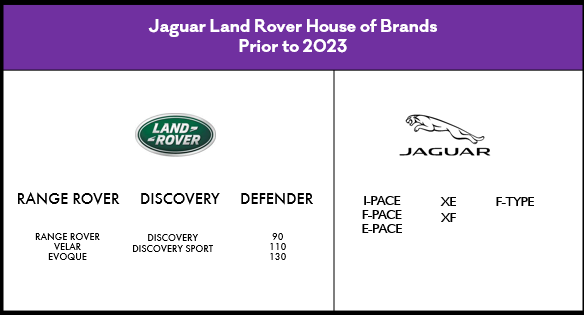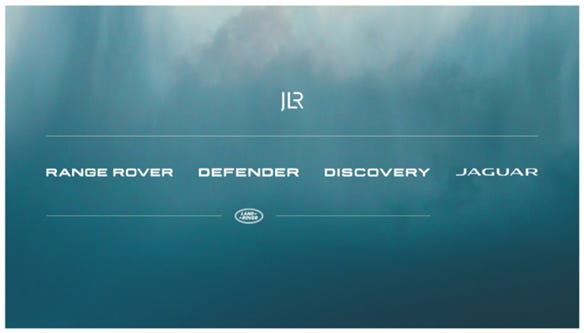


JLR RE-BRAND: SMART OR SELF-INDULGENT?
Brand architecture case study: Why use two of the best recognised logos in the world when you can invent five

BMSB (Brand Marketing for Smaller Brands) has never owned a Jaguar, but has owned 8 consecutive Land Rovers (sorry, at two points we had ‘his ‘n hers’ LRs) and have never been without one (or two) since 1987. It is one of very few brands I have a real (some would say misplaced – but that’s the thing about love) affection for. So I feel I have some skin in the game for this one.
I was so taken with the fresh looks of the 2008 show car that I ordered a Land Rover Evoque (wrong name – but bear with me) without either seeing or driving one when it was launched 2 years later. And conflating LR ownership with brand strategy got me into trouble soon after so maybe I’m playing a dangerous game.
But I was puzzled by the naming hierarchy. This led me to suggest on an Evoque website forum that the Evoque should have been referred to as simply the Land Rover (the marque) Evoque (the model). Oh the fury and indignation of an owner’s forum. I quickly realised that for most Evoque owners of the time, owning a ‘Baby Range Rover’ was a very big part of the product appeal.
But this lead to the convoluted brand architecture involved in a ‘Land Rover Range Rover Evoque’ as even LR themselves tended to call it. It was obvious Land Rover had a problem – but it was one in my view of their own making – but we’ll come to that.
The industry was pretty dismayed when JLR announced their new brand strategy in June 2023. Not least the dealers who were going to have to share the costs of implementing the new branding.
So following the principles and approaches outlined in my last two brand architecture articles – did JLR do the right thing in terms of brand architecture?
Existing brand assets
The automotive market is truly global now really. But there are five brands still probably perceived as quintessentially British (although none have British-based owners.) These would be Rolls Royce (BMW), Bentley (VW House of Brands) followed by Jaguar and Land Rover (Tata). These could all probably be described as luxury brands. The fifth is Mini (BMW.)
The Land Rover logo has evolved from a dark grey oval to this version over 70 years, and was pretty much unchanged in the last 30. Quite a provenance.

Probably even better recognised is the Jaguar logo. The first Jaguar car was produced in 1922, and the leaping jaguar logo first appeared in 1945. Classic Jaguars had a distinctive chrome sculpture on the bonnet (or hood) to rival Rolls Royce’s Spirit of Ecstasy. The logo looked like this.

These are the two immensely valuable brand assets owned by what became Jaguar Land Rover.
In my first article on brand architecture I picked VW as an automotive example of a House of Brands. VW have a wide brand collection that includes supercars and superbikes as well as more mundane car brands. But I don’t think that anyone would argue that the marques below are not brands. But what about product ranges and products? Is ‘911’ a brand? It’s a moot point which you could argue all day. However, I do think that you could develop objective criteria to identify which car models have achieved brand status. I think the key criteria would be distinctness and recognition. Arguably ‘911’ is at least a sub-brand.

So what did JLR’s brand architecture look like in 2023? Like this:

Jaguar Land Rover branding pre-2024
From this I would say that the Land Rover brand had three sub-brands many consumers would recognise. Range Rover being closest to being a brand in its own right. It’s a mouthful, but owners of a Velar or Evoque would say (proudly) “I have a Range Rover Xxxxx”, (probably not being quite disingenuous enough to say: “I have a Range Rover”. Their friends might say they “Have a Land Rover”. And with the mess JLR got into talking about a ‘Land Rover, Range Rover Evoque’. Why did they need to? After all they never called the Range Rover the ‘Land Rover Range Rover Range Rover’.
The only recognisable brand to a typical consumer at Jaguar is – Jaguar. They have three types of vehicle – SUVs, luxury saloons/sedans and a sportscar. The latter two are legacy ranges due for the chop. Maybe ‘Pace’ will reach sub-brand status – we’ll see – but I rather doubt it.
So did JLR actually have a problem they needed to address? Maybe they thought that as the most luxurious off-roader Range Rover needed elevating. I have heard from industry insiders that ‘Range Rover’ was a better recognised brand in the US than Land Rover and they wanted to push it as a brand in its own right. But did that mean they had to get rid of the storied Land Rover brand? The Land Rover range unlike many competitors is very distinct – and easy to understand. They are all luxury off-roaders with class-leading cross-country credentials. Defender is the most workmanlike, Range Rover the most luxurious. Why mess with that?
Well JLR chose to anyway. This is how they announced it.
Jaguar Land Rover unveils new JLR corporate identity as it accelerates modern luxury vision:
Jaguar Land Rover unveils new corporate identity as it evolves to JLR
New JLR identity embodies elegance, modernity and the company’s forward-thinking essence
As announced, Range Rover, Defender, Discovery and Jaguar brands to be amplified under House of Brands approach
Land Rover heritage mark to remain integral and will be visible on our vehicles, online platforms and retail sites
New JLR identity is next step in Reimagine strategy and reflects company’s modern luxury ambition
So this is JLR after the re-brand.

Land Rover Jaguar brand architecture pre and post 2023
And the visual from JLR when they announced it:

“The creative process behind the new identity focused on elegance, modernity and a forward-thinking essence to exhibit the direction and ambition of the company.”
What do you notice? Firstly – JLR’s most recognisable brand assets have disappeared. JLR had two brand assets – with a visual heritage stretching back a combined 150 years – and they’ve gone. So JLR have replaced two highly recognisable brand assets with five. Five that are not really distinct either between themselves or standing alone. From a brand identity point of view it seems an astonishing decision. While I would concede the point about Range Rover perhaps qualifying as a brand itself, and the product being unusually distinct and recognisable, the logo hardly qualifies as a distinct asset.
The other point may only be obvious to a brand pedant like me and I am biased by all the brand workshops I have done with clients. My favourite exercise is to get both consumers and clients (in different sessions) to organise all the brands in a category against a continuum variable to see what comes up. Similarly, it seems to me that the three Land Rover sub-brands fall neatly into a continuum that goes obviously from most rugged to most luxurious. If you put the most recognised sub-brand on the left - Range Rover - then logically the next should be Discovery and then Defender. In its own small but important way, these factors aid understanding of a brand.
In practice it might not seem as bad as it looks. Contrary to the way the new identity was reported, JLR haven’t completely dropped the Land Rover logo. It remains as an endorsement and will still be used on the vehicles. This dilutes the impact of the changes in my view, but overall is the new architecture a good idea? If your only measure is brand distinctness and consumer recognition (it should be) then I think it is a bad move. JLR are (largely) discarding two highly recognisable brand logos and now have to promote five. Remember the first rule of branding from our first brand architecture article – as a rule of thumb, it will cost you twice as much to promote and build two brands as one.
So how would you describe the new JLR brand architecture? When I discussed this series of articles with my colleague Kathrin Rodriguez-Brüssau we talked about identifying ‘hybrid’ models that had evolved (brand architecture that it - not vehicles!). However, on deeper examination, we decided that like logos, good brand architecture simplifies over time. As such, all good architecture followed the rules (i.e. was one of the five models we identified in our first article). And that a hybrid model was really an indication of a flawed model. This is where I think JLR have ended up. They have moved from a very clear and simple House of Brands (with JLR) essentially the almost anonymous brand owner like P&G) to a branded house (because they have chosen to turn JLR into a brand. However, they will endorse some of their brands (Range Rover, Discovery, Defender) with what used to be their brand (Land Rover). As such, their model is an ‘Endorsed brands branded house’. The irony of this is that JLR themselves stated (above) that this was move TO “a House of brands approach”. Oh dear. Good move? Another model or flawed model? Let us know what you think!
Posted 22 March 2024 by Chris Bullick